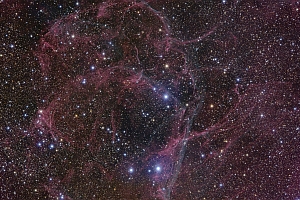Vela SNR & Neighbours is the topic of Part #7 of our image presentation, where we want to share the results from our astrophotography-trip to the Hacienda Los Andes in Chile.
The Vela supernova remnant is located in the southern constellation Vela and with a distance of aprox. 800 light years it is one of the closest SNRs to our solar system. Its a roughly 11 000 to 12 000 year old leftover from a type II supernova explosion in our Milky Way galaxy. The Pencil Nebula - NGC 2736 - is a very small but quite famous part of the Vela SNR.
Gum 15 is a beautiful HII region in constellation Vela, where massive star formation takes place at the moment. The brightest star within Gum 15 is HD 74804 which belongs to the open cluster Collinder 197. Gum 23 is another nice HII region which is ionised by the enormous start cluster G267.92-01.06, which is less than 1 million years old an contains about 2000 stars. NGC 2626 is a small and faint reflection nebula, located in northern Vela.
NGC 3201 is a globular cluster in the southern constellation of Vela which has a very low central concentration of stars. The radial velocity of this cluster is unusually high at 490 km/s - larger than any other known cluster. The bright open star cluster NGC 2547 is also located in constellation Vela and has been discovered by Nicolas Louis de Lacaille in 1751 from South Africa. Another open cluster in Vela is Pismis 4. This cluster is at the edge of the Vela supernova remnant, as indicated by the attractive filaments you can see in the image. There are aprox. 45 stars identified in the cluster with the brightest at mag 7.3.









